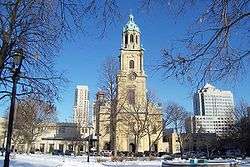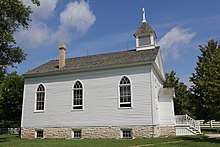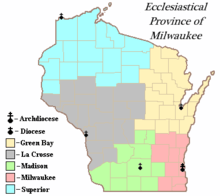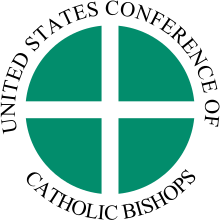Roman Catholic Archdiocese of Milwaukee
The Archdiocese of Milwaukee (Latin: Archidioecesis Milvauchiensis) is a Roman Catholic archdiocese headquartered in Milwaukee, Wisconsin in the United States. It encompasses the City of Milwaukee, as well as the counties of Dodge, Fond du Lac, Kenosha, Milwaukee, Ozaukee, Racine, Sheboygan, Walworth, Washington and Waukesha, all located in Wisconsin. The Archdiocese of Milwaukee is the metropolitan see of the ecclesiastical province of Milwaukee, which includes the suffragan dioceses of Green Bay, La Crosse, Madison, and Superior. As of 2020, Jerome Edward Listecki is the Archbishop of Milwaukee.
Archdiocese of Milwaukee Archidioecesis Milvauchiensis | |
|---|---|
 Cathedral of St. John the Evangelist | |
 | |
| Location | |
| Country | |
| Territory | The City of Milwaukee and the counties of Dodge, Fond du Lac, Kenosha, Milwaukee, Ozaukee, Racine, Sheboygan, Walworth, Washington and Waukesha in the state of Wisconsin |
| Ecclesiastical province | Milwaukee |
| Statistics | |
| Area | 4,758 sq mi (12,320 km2) |
| Population - Total - Catholics | (as of 2013) 2,369,000 673,000 (28.4%) |
| Parishes | 204 |
| Schools | 111 |
| Information | |
| Denomination | Catholic |
| Sui iuris church | Latin Church |
| Rite | Roman Rite |
| Established | November 28, 1843 (176 years ago) Elevated to Archdiocese on February 12, 1875 |
| Cathedral | Cathedral of St. John the Evangelist |
| Patron saint | St. John the Evangelist |
| Secular priests | 334 |
| Current leadership | |
| Pope | Francis |
| Archbishop | Jerome Edward Listecki |
| Auxiliary Bishops | Jeffrey Robert Haines James Thomas Schuerman |
| Bishops emeritus |
|
| Map | |
_map_1.jpg) | |
| Website | |
| archmil.org | |
History
The Diocese of Milwaukee was constituted November 28, 1843 by Pope Gregory XVI. It was elevated to Archdiocese on February 12, 1875 by Pope Pius IX.[1] The Cathedral of St. John the Evangelist is the episcopal see.

The first Mass, was celebrated in Milwaukee as early as 1837 by Rev. J. Bonduel, a missionary from Green Bay, in the home of French Canadian fur trader, Solomon Juneau. In the same year Rev. Patrick Kelly came to the city and held services in the court-house till, in 1839, he erected the first Catholic church, dedicated to St. Peter, for several years the bishop's cathedral. The small, clapboard-sided church was replaced in 1853 by the Cathedral of St. John the Evangelist on North Jackson Street. Msgr. Leonard Batz, vicar general of Milwaukee had the old church later moved to the SS. Peter and Paul property.[2]
In 1841 Bishop Pierre-Paul Lefevere, coadjutor/administrator of the Diocese of Detroit visited as Milwaukee was part of that diocese. Two years later, Milwaukee was made a separate diocese. John Henni, vicar general of the Diocese of Cincinnati was appointed the first bishop. Henni found He found only four priests in the whole diocese, ministering to a few Catholics, mostly immigrants from Germany and Ireland, scattered over the territory, and a small frame church encumbered with debt.[3]

In 1846, Old St. Mary's Church, designed by Victor Schulte in Zopfstil style, was built to serve the German Catholic immigrants in Milwaukee. The Annunciation altarpiece, painted by Franz Xavier Glink was donated by King Ludwig I of Bavaria.[4] In 1847 Henni laid the foundation of the new cathedral, dedicated to St. John the Evangelist, also designed by Schulte. Built of Cream City brick, a cream or light yellow-colored brick made from a clay found around Milwaukee,[5] the cathedral was consecrated by Papal nuncio Archbishop Gaetano Bedini 31 July 1853. In 1866 two new dioceses were established in Wisconsin with episcopal sees in La Crosse and Green Bay. In 1875 Milwaukee was made an archiepiscopal see, with Bishop Henni as first archbishop.
Upon the death of Henni in September 1881, he was succeeded by Michael Heiss, Bishop of La Crosse. Heiss had previously served as secretary to Henni, pastor of St. Mary's, and rector of Saint Francis de Sales Seminary. At Saint Francis, Heiss trained German-speaking priests to serve German Catholics of the archdiocese.[6] An esteemed theologian, he served as one of the members of the dogmatic commission at the First Vatican Council. In 1888 the Diocese of St. Paul was separated from Milwaukee.
Swiss-born Sebastian Gebhard Messmer was installed as Archbishop of Milwaukee in December 1903. He had previously served as a professor of theology at Seton Hall College, pastor of St. Peter's Church in Newark, professor of canon law at the Catholic University of America,[7] and Bishop of Green Bay. During Messmer's tenure, twenty nine religious congregations established ministries in the archdiocese.
The Bennett Law
Archbishop Heiss was followed in 1890 by Bishop of Green bay, Frederick Katzer, whose appointment, as the third German-speaking archbishop, was not universally well-received by the Irish. Shortly before his arrival, Wisconsin passed the Bennett Law which required that major subjects in all public and private elementary and high schools be taught in English. This was perceived as an attack on immigrants and parochial schools. As German Catholics and Lutherans each operated large numbers of parochial schools in the state where German was used in the classroom, it was bitterly resented by German-American, predominantly Catholic Polish Americans, and some Norwegian communities. The law was endorsed and promoted by among others, the anti-Catholic American Protective Association. Representatives of the group also made public announcements that the Roman Catholic hierarchy had instigated the Civil War.[8] They also circulated forged documents, including an alleged Papal encyclical purportedly over the signature of Pope Leo XIII calling for Catholics to "exterminate all heretics" on or about St. Ignatius Day [September 5], 1893.[9]
"Most all of the better class of immigrants are Protestants. It remains that, almost entirely, the lowest class are Roman Catholics.... Among these are mostly found the train wreckers, robbers, plunderers, murderers, and assassins of the country.... In the large cities criminal statistics show that while Roman Catholics furnish about four percent of the population, they produce more than one-half of the crime, if we except those cities in which there is a large percent of negro criminals."[10]
The group sought to exert influence by boosting its supporters in campaigns and at political conventions, particularly those of the Republican Party. Archbishop Katzer lobbied strongly for the repeal of the Bennett Law in 1890. Traditionally Democratic Irish Catholics were initially not as vigorous in opposition to the law, with a substantial section of the community even supporting it, as Governor Hoard had hoped. However, the outpouring of militantly anti-Catholic rhetoric by many of the law's supporters alienated a majority of the Irish in Wisconsin, prompting the top Irish newspaper in the state, the Chippewa Falls-based Catholic Citizen, to write that the law represented a convergence of "all the sectarian, bigoted, fanatical and crazy impurities" within the Republican Party which had taken the reins of power.[11] The law was repealed in 1891.
Sexual abuse scandal
In a report released by the Wisconsin State Senate in 2003, a total of 58 priests were revealed to have been accused of sexually abusing children while serving in the Archdiocese of Milwaukee.[12] Weakland admitted allowing priests guilty of child sex abuse to continue as priests without warning parishioners or alerting the police.[13] Weakland stated in his autobiography that in the early years of the sexual abuse scandal he did not understand that child sexual abuse was a crime.[14]
On March 18, 2019, it was announced that former Archbishops William Cousins and Rembert Weakland would have their names removed from buildings in the Archdiocese of Milwaukee due to their poor handling of sex abuse cases.[15] The renaming of Archdiocese of Milwaukee office centers which were named in their honor commenced on March 22, 2019.[16]
Bankruptcy
On 17 July 2011 the archdiocese launched "a national advertising campaign to notify sex abuse victims of their deadline to file claims. The archdiocese filed for Chapter 11 bankruptcy protection in January after it failed to reach a settlement with two dozen victims of sexual abuse by Catholic clergy."[17] About 550 people are asking for restitution for alleged sexual abuse by clergy in the Archdiocese of Milwaukee.[18] The archdiocese paid financial settlements to claimants funded "through various sources, including insurance, loans and the sale of property", and funds were set aside to pay for therapy.[19]
Demographics
The Archdiocese of Milwaukee has a membership of 591,890 Catholics in 198 parishes, representing the most heavily Catholic region of the state. There are 322 diocesan priests, 370 religious priests, and 147 permanent deacons. Religious orders include 82 brothers and 994 women religious.[20]
The archdiocese houses one provincial seminary (St. Francis de Sales Seminary) educating 56 seminarians.[21] It oversees 94 elementary schools, 13 high schools, and five colleges and universities.
Also included in the archdiocese are 12 Catholic hospitals and 9 Catholic cemeteries.[20]
Bishops
The following are lists of the Roman Catholic Bishops and Auxiliary Bishops of the Archdiocese of Milwaukee and their years of service.
Archbishops of Milwaukee
- John Martin Henni (1844–1881)
- Michael Heiss (1881–1890)
- Frederick Katzer (1890–1903)
- Sebastian Gebhard Messmer[22] (1903–1930)
- Samuel Stritch (1930–1940), appointed Archbishop of Chicago (Cardinal in 1946) and later Pro-Prefect of the Sacred Congregation for the Doctrine of the Faith
- Moses E. Kiley[23] (1940–1953)
- Albert Gregory Meyer (1953–1958), appointed Archbishop of Chicago (Cardinal in 1959)
- William Edward Cousins (1959–1977)
- Rembert Weakland, O.S.B. (1977–2002)
- Timothy Michael Dolan (2002–2009), appointed Archbishop of New York (Cardinal in 2012)
- Jerome Edward Listecki (2010–present)
Auxiliary bishops
- Joseph Maria Koudelka (1911–1913), appointed Bishop of Superior
- Edward Kozłowski (1913–1915)
- Roman Richard Atkielski (1947–1969)
- Leo Joseph Brust (1969–1991)
- Richard J. Sklba (1979–2010)
- William P. Callahan, OFM Conv. (2007–2010), appointed Bishop of La Crosse
- Donald J. Hying (2011–2015), appointed Bishop of Gary and later Bishop of Madison
- Jeffrey Robert Haines (2017–present)
- James Thomas Schuerman (2017–present)
Other priests of the Archdiocese of Milwaukee who became bishops
The following men began their service as priests in Milwaukee before being appointed bishops elsewhere:
- Raphael Michael Fliss, appointed Coadjutor Bishop of Superior in 1979
- Francis Joseph Haas, appointed Bishop of Grand Rapids in 1943
- Jerome J. Hastrich (priest here, 1941-1945), appointed Auxiliary Bishop of Madison in 1963 and later Bishop of Gallup
- James Michael Harvey, appointed Prefect of the Prefecture of the Papal Household and Titular Bishop in 1998 (later elevated to Titular Archbishop) and later Archpriest of the Basilica of Saint Paul Outside the Walls (elevated to Cardinal in 2012)
- David John Malloy, appointed Bishop of Rockford in 2012
- Aloisius Joseph Muench, appointed Bishop of Fargo in 1935 and Apostolic Nuncio to Germany (elevated to Cardinal in 1959)
- William Patrick O'Connor, appointed Bishop of Superior in 1941
- Joseph Perry, appointed Auxiliary Bishop of Chicago in 1998
- Augustine Francis Schinner, appointed Bishop of Superior in 1905
- Paul Francis Tanner, appointed titular bishop in 1965 and later Bishop of Saint Augustine
- Fabian W. Bruskewitz, appointed Bishop of Lincoln in 1992
Churches
Basilicas
- Basilica of St. Josaphat, Milwaukee
- Holy Hill National Shrine of Mary, Help of Christians, a minor basilica, Hubertus, Wisconsin
Shrines
- Archdiocesan Marian Shrine, Milwaukee
Schools
- See List of Schools in the Roman Catholic Archdiocese of Milwaukee
Ecclesiastical province

The ecclesiastical province of Milwaukee comprises the state of Wisconsin and includes these suffragan dioceses.
- Diocese of Green Bay
- Diocese of La Crosse
- Diocese of Madison
- Diocese of Superior
See also
- List of the Catholic dioceses of the United States
- List of Roman Catholic dioceses (alphabetical)
- List of Roman Catholic dioceses (structured view)
- Sexual abuse scandal in Catholic archdiocese of Milwaukee
References
- Archdiocese of Milwaukee. About Us.
- Les Vollmert; Paul Jakubovich (1989-07-25). "NRHP Inventory/Nomination: Saints Peter and Paul Roman Catholic Church Complex". National Park Service. Retrieved 2017-09-28. With 23 photos.
- Rainer, Joseph. "Milwaukee." The Catholic Encyclopedia Vol. 10. New York: Robert Appleton Company, 1911. 13 March 2020

- "Old St. Mary's Church". Wisconsin Historical Society. Retrieved 2020-02-09.
- Perrin, Richard W.E. (1979). Milwaukee Landmarks: An Architectural Heritage, 1850-1950. Milwaukee: Milwaukee Public Museum. pp. 7–9. ISBN 0-89326-044-4.
- "Archbishop Michael Heiss". Roman Catholic Archdiocese of Milwaukee.
- "Mgr. Messmer Dies; American Prelate". The New York Times. August 5, 1930.
- Albert Clark Stevens, The Cyclopædia of Fraternities: A Compilation of Existing Authentic Information and the Results of Original Investigation as to More Than Six Hundred Secret Societies in the United States. New York: Hamilton Printing and Publishing Co., 1899; pg. 295
- Desmond, Humphrey Joseph. The APA Movement: A Sketch. Washington: New Century Press, 1912
- Scott Funk Hershey, Errors of the Roman Catholic Church : and its insidious influence in the United States and other countries by the most profound thinkers of the present day, and the history and progress of the American Protective Association (A.P.A.) "Errors of the Roman Catholic Church: And Its Insidious Influence in the United States and Other Countries by the Most Profound Thinkers of the Present Day, and the History and Progress of the American Protective Association (APA).] St. Louis: J.H. Chambers, 1894; pg. vi.
- Jensen, Richard J. The Winning of the Midwest: Social and Political Conflict, 1888-1896 (1971) pp. 138-139
- "The Sexual Abuse of Children in the Archdiocese of Milwaukee". www.bishop-accountability.org.
- Archbishop Rembert Weakland, Former Catholic Bishop Of Milwaukee, Says He's Gay Archived March 3, 2016, at the Wayback Machine
- "Archived copy". Archived from the original on September 17, 2013. Retrieved 2013-08-10.CS1 maint: archived copy as title (link)
- Anderson, Andrea (March 19, 2019). "Milwaukee Archdiocese Removes Names Of 2 Priests From Buildings". Wisconsin Public Radio.
- "Milwaukee Archdiocese reveals new name of its Diocesan offices; 'Looking really to restore trust'". March 22, 2019.
- "WEAU.com: Archdiocese ads notify abuse victims of claim deadline, 17 July 2011". Retrieved 2 September 2017.
- "Milwaukee Archdiocese faces 550 sex abuse claims". Retrieved 2 September 2017.
- "2019 - Clergy Abuse Q&A". www.archmil.org.
- "About". www.archmil.org. Retrieved 2 September 2017.
- "Saint Francis de Sales Seminary | Our Seminarians". www.sfs.edu.
- Archdiocese of Milwaukee. Archbishop Sebastian Gebhard Messmer.
- Archdiocese of Milwaukee. Archbishop Moses Elias Kiley.
![]()
Further reading
- Avella, Steven M. Confidence and Crisis: A History of the Archdiocese of Milwaukee, 1959–1977 (Milwaukee: Marquette University Press, 2014. 344 pp.
External links
| Wikimedia Commons has media related to Roman Catholic Archdiocese of Milwaukee. |
